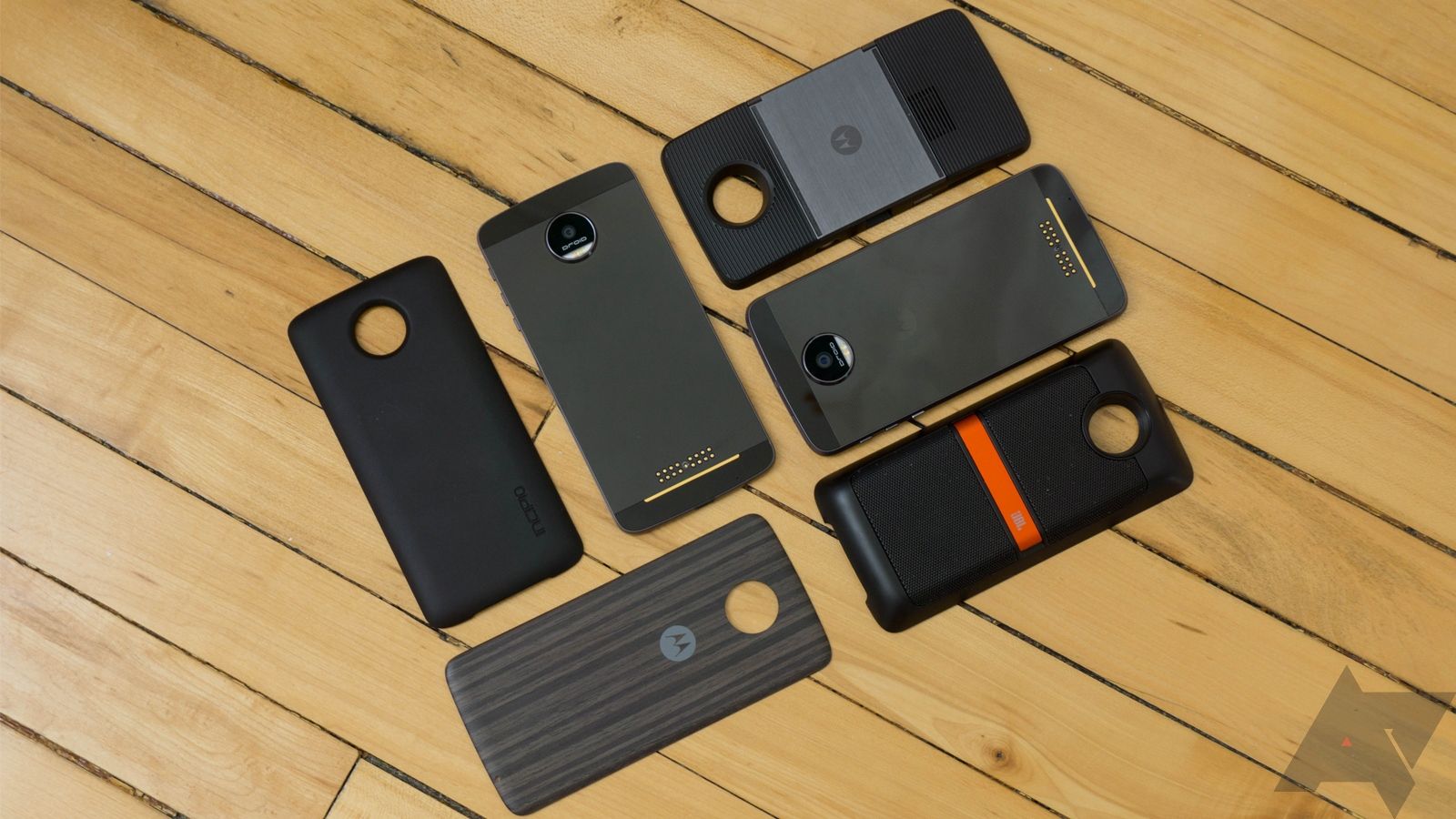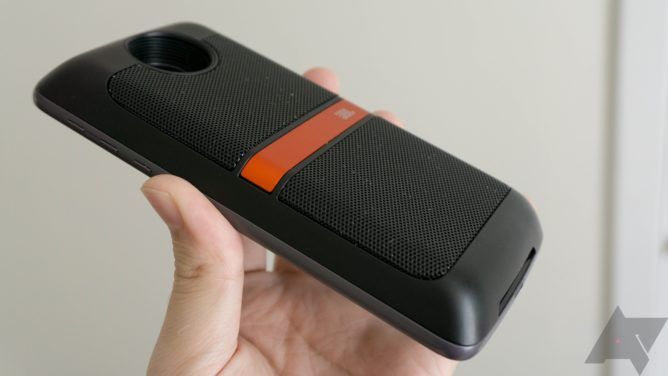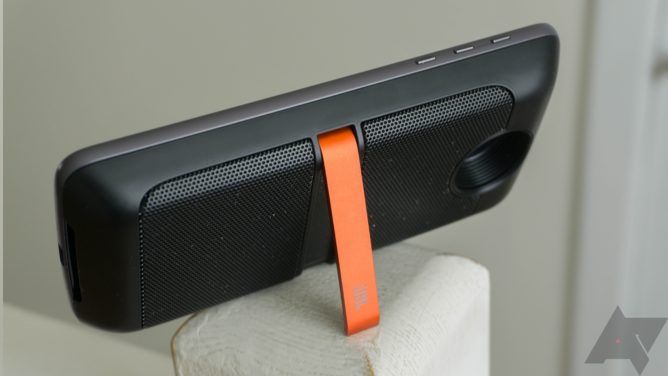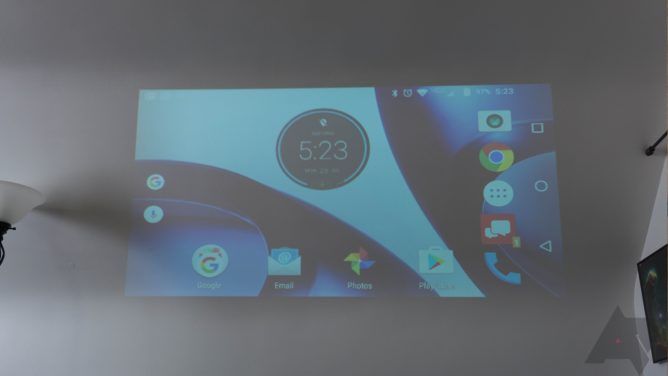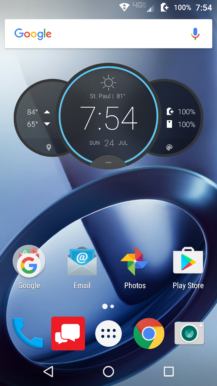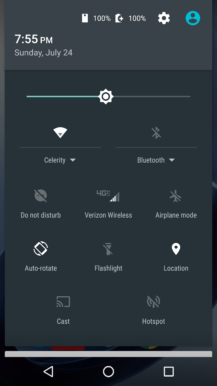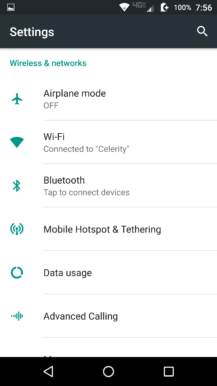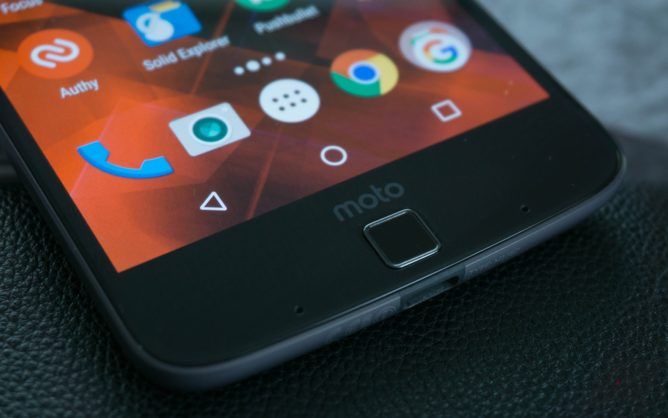Quick Links
Motorola is trying something new—it's like a whole new company with new owners, new phones, and a new approach to making money on said phones. The Moto Z and Z Force (currently only available as Verizon exclusives) are "modular" phones with a series of snap-on rear panel accessories. They're also very thin and lacking a headphone jack. There are certainly reasons to be skeptical of these devices, but they're also very interesting in an industry that has had trouble innovating beyond the standard black slab.
Motorola has priced the Moto Z phones much higher than the last flagship Moto X, but do they warrant that? Spoiler: I think the use case for the Moto Z is extremely narrow, but that doesn't mean it's necessarily a bad phone. Let's break it down.
SPECS
|
SoC |
Snapdragon 820 |
|
RAM |
4GB |
|
Display |
5.5-inch 1440p AMOLED (ShatterShield technology on Force) |
|
Storage |
32GB plus microSD card |
|
Battery |
2600mAh (Moto Z), 3500mAh (Moto Z Force) |
|
Camera |
13MP (Moto Z), 21MP (Moto Z Force) |
|
Measurements |
5.19x75.3x153.3mm, 136g (Moto Z) - 6.99x75.8x155.9mm, 163g (Moto Z Force) |
|
Price |
$624 (Moto Z), $720 (Moto Z Force) |
THE GOOD
|
Performance |
The Moto Z and Z Force are some of the fastest phones I've used. |
|
Design |
The Moto Z is really, really thin and light, if you're into that. |
|
Cameras |
The best cameras Motorola has ever produced, and competitive with other premium phones. The camera app is much improved too. |
|
Display |
The 1440p AMOLED panel looks fantastic. ShatterShield on the Force is legitimately shatter-resistant. |
|
Fingerprint sensor |
It's fast and accurate. |
|
Software |
Stock-ish Android with Motorola enhancements. Moto Display is still rad. |
THE NOT SO GOOD
|
Battery life |
The Moto Z's battery life is not good enough. |
|
Design again |
The completely flat back and huge camera hump is not the best look. The button layout is poor as well. |
|
Verizon exclusivity |
Only the Moto Z will come out as an unlocked device, and it will only support GSM/LTE. |
|
The Mods |
None of the Mods available at launch are very compelling. They're all too heavy to carry around, and the speaker and projector are impractical on a basic level. |
|
No headphone jack |
Why, Motorola? This adapter nonsense is terrible. |
|
Pricing |
Motorola has priced these phones higher than the Moto X, which is fine. However, it expects you to buy Mods priced $60-300 in addition? Boo. |
Design and display
The Moto Z and Moto Z Force have a lot in common, except when it comes to some elements of the external design and display. The first thing you'll notice when picking up the Moto Z is that it's almost unbelievably thin at just 5.19mm, and it weighs 136g. That's impressive for a phone with a 5.5-inch display. The phone's flat aluminum back isn't the most comfortable, but it's saved somewhat simply because it's so light. There's an unusual texture to the aluminum panel that makes it a bit of a fingerprint magnet—not something I'd usually expect from a metal phone.
The camera sticks out on the back of both phones several millimeters, and the bottom has the exposed pins for the Moto Mod accessories. It looks somewhat unfinished to me, probably because Motorola really, really wants you to put some Mods on it. The phone comes with a simple style shell that brings the camera hump flush with the rear surface (they're quite thick). It makes the phone feel more normal in the hand. Although, that seems like it defeats the purpose of making the phone so thin if you use the cover all the time. And Motorola pushes the thinness angle. All the promo images of the phone are either with mods or bare. The style shells are rarely shown.
The buttons are all on the right edge toward the top, and as I said in the hands-on post, I'm not really a fan. They're clicky and don't rattle around, but the separation is poor. The power, volume up, and volume down buttons are all the same size and shape with the same distance between them. That makes it hard to find the right one by feel—you have to run your finger over them a few times to feel for the different texture of the power button. Luckily, I haven't had to use the buttons much. The fingerprint sensor can be used to wake and unlock the phone, and a long-press of the sensor puts the phone back to sleep. That takes a little getting used to so you don't accidentally put your finger on it while using the phone, but it's very handy.
As for the fingerprint sensor itself, it performs very well. I'm more in favor of rear-facing sensors, and this one looks rather tacked on. Still, it's very fast and accurate. I have not had to worry about the angle my finger is at when reading, and it responds quickly. I don't think I've had more than a handful of failed attempts in my time using the phone.
On the bottom is the USB Type-C port... the only port. As you've all probably heard by now, this phone has no headphone jack. I'm going to come out now as strongly pro-3.5mm jack. It's far too soon to abandon this port, and the Moto Z is a worse phone for trying. For one, there's no way currently to charge and have audio out at the same time. Maybe an adapter will come out eventually, but it doesn't exist yet. There's an adapter in the box that turns the Type-C plug into a standard 3.5mm jack, but that's another thing to carry around. If you lose it (and I'm sure I will), good luck finding a quick replacement. I've already encountered a few instances where I needed a 3.5mm jack, but I didn't have the adapter. So, I just didn't have audio. This is a dumb decision, and I'm not convinced it's only because of the phone being too thin. The Z Force is definitely thick enough and it doesn't have one either. Moto wants this for some reason.
Being so thin, there's potential for the Moto Z to feel too angular, but the edges have a nice rolled shape that blends smoothly into the 2.5D front glass panel. It's actually grown on me as I've used it. The Force, however, is thicker at 6.99mm and the front does not have that same 2.5D glass panel. In fact, it's plastic. That's because the Force has Motorola's ShatterShield technology. That includes multiple layers of impact-resistant plastic that won't crack. I've given it a few solid wacks, and yep, no cracks. I don't know that it's worth the trade-offs to me, though. The edge is flat instead of curved, and it's rather sharp. Because it's plastic, the screen on the Moto Z Force can scratch, which the Gorilla Glass on the Moto Z will not. Indoors the screens look identical, but the plastic layers on the Z Force have strange reflectivity outdoors that I'm not crazy about.
The 5.5-inch AMOLED display definitely looks like something you'd see in a premium smartphone, and AMOLED makes much more sense considering Motorola's Moto Display feature. The LCD on the Moto X Pure was an outlier. With the 1440p AMOLED, you get perfect contrast and black levels for Moto Display, and the screen's other qualities are nice too. The viewing angles are perfect; I see no color casting or dimming at all. The brightness is sufficient to use outdoors, and the colors are solid. Neither of these are as good as the Galaxy S7, which continues to have the best AMOLED I've seen. Still, it's a very attractive screen.
I will note that the default "vibrant" calibration is a little too rich if you want accurate colors. You might want to flip that to "standard" in the settings. Below the screen are the two motion sensors that wake up Moto Display when you wave your hand over. I'm happy Motorola kept this feature.
Cameras
The camera is another place where Motorola is trying to differentiate the Moto Z and Moto Z Force. The regular Moto Z has a 13MP camera and the Z Force has a 21MP camera. Both of them include an f/1.8 aperture, laser autofocus, optical image stabilization, and a dual LED flash. Oh, and the front-facing 5MP camera has a selfie flash.
The higher resolution camera on the Z Force seems to be slightly better for capturing detail (duh), but I don't think it's a significant enough difference to make the regular Moto Z look bad. Outdoor shots look virtually identical if you don't crop or zoom. Exposures are very even on both, but that comes from HDR mode flipping on fairly often—you'll get a popup telling you to hold steady. That will mean longer capture times. The cameras just aren't as fast as Samsung's or LG's flagship devices.
Some Moto Z samples:
Indoors, both of them have reasonably good color balance and not too much noise in darker areas. Again, you'll see some extended capture times when light is less than ideal, this time thanks to night mode. As with HDR mode, you'll get a popup that tells you to hold the device steady. The Moto Z Force starts to pull ahead when light gets a bit dimmer. It has less noise, more accurate white balance, and better colors. Weirdly, I feel like the regular Moto Z does better in low light, mostly because it has more consistent white balance in these situations. Both will get a little noisy, but the photos are usable. Again, neither of these phones does as well as the best Android cameras out there, but they're competitive. There are no glaring issues that I would consider deal breakers. The shutter lag is just a little long, but I hope Motorola can address it.
Moto Z Force samples:
So, the cameras are acceptable for flagship phones, but not awe-inspiring. I am, however, a little in awe of how much better Motorola's camera app has gotten. For years the company has insisted on the tap to capture interface, which was mutually exclusive with standard tap to focus. Now, the default is to have a shutter button, thank goodness. There's also a pro photo mode with adjustable sliders for exposure, white balance, focus, and so on. It's the same app now available on the Moto G4. It's a vast improvement over Motorola's old camera app.
Performance and battery
The Moto Z phones have some issues, sure, but speed is not one of them. Unless you consider going too fast a problem. I mean, I don't. Both phones have Snapdragon 820 SoCs and 4GB of RAM. I've got a few benchmarks below, if you're into that sort of thing.
These phones are fast to the point that you can actually tell a difference using them compared to other similarly specced phones. Scrolling, multitasking, web page rendering, and all the other general smartphone things are buttery smooth on the Moto Z and Moto Z Force.
Gaming too is great on the Moto Z phones. I've been playing various casual games like Shooty Sky and Rooms of Doom without issue. Trainers take note: Pokémon GO runs as well on this phone as any I've tried. More visually complex games like CSR Racing 2 and Warhammer 40k: Freeblade perform extremely well too. The only issue I'd cite is that the phone can get uncomfortably warm during extended use. I assume this is because it's thin and has an aluminum frame that transmits heat away from the internals.
While I'm happy with the raw speed on display here, that leads to less than impressive battery life. The Moto Z has a small 2600mAh battery—that's even smaller than the Moto G4. The Moto Z Force bumps that up to 3500mAh. With a 5.5-inch 1440p AMOLED, I was not expecting the battery life on the Moto Z to be great, but actually living with it is problematic. Smartphone battery life has been moving in the right direction over the last few years as even Samsung started making phones thicker to accommodate larger cells. The Moto Z, however, is solidly below average.
I'm able to make it through a day with the Moto Z most of the time. This phone is usually begging for the charger in the early evening, and I'd certainly never go out after work without juicing it up a little (luckily, Motorola's Turbo Power charging is really fast). With moderate usage including messaging, light gaming, email, and web browsing, I'm seeing barely three hours of screen time on the Moto Z. I don't think that's good enough, and this phone is new. The battery life will deteriorate over time. Under similar conditions, the larger battery in the Moto Z Force will make it through a day no problem with capacity to spare. It will easily hit five hours of screen time too.
So, I'd consider the Moto Z Force's battery life to be average to slightly above average for a 5.5-inch phone. Meanwhile, the Moto Z is barely limping along. In both cases, I think Motorola is overstating the battery life in its specs. But wait, there's always the battery Mod, right?
Mods
Motorola's big push this year is the line of modular accessories called Moto Mods. The Mods are held on with magnets and fit around the camera lens, sometimes leaving the sensor in a comically deep well. I have a hard time calling these "modular" because they don't replace anything on the phone. You're just sticking something to the device with magnets, but if modular is the buzz word, then modular it is.
There are three Mods at launch, and more will be released later. There's even a dev kit for third-parties to design new Mods. Motorola says the Mods it's selling now will be compatible with future Moto Z phones, which I suppose might help you justify the exorbitant prices. I have a very hard time recommending these just on the basis of the cost/value. Let's hit all three.
Incipio offGRID Power Pack
The Power Pack battery Mod is probably the one that makes the most sense. I can see people buying this, because frankly, the Moto Z's battery life is poor. So, you slap the Mod on and get 2200mAh of extra power, plus wireless charging (in some versions). Neat. What's not neat is that the Power Pack makes the Moto Z very uncomfortable to hold. It adds 6.2mm of thickness for a total of 11.39mm with the Z and 13.19mm with the Z Force. That's really thick—it's like going back in time three of four years to when phones were beefier.
More significant here is the weight. The Moto Z with Mod is (by my measurement) 232g. That is heavier than the massive Cat S60. The Z Force with Mod is 256g. Anyone who tells you the battery Mod is "sleek" or "compact" is either confused or only using those words in relation to an external battery pack connected via a USB cable. That's what these are... minus the cable and plus some magnets.
When connected, the Power Pack charges your device battery, keeping it at 100%. There's also an efficiency mode that keeps it at 80%. Whenever a Mod is connected, you'll get a notification and settings screen that shows the battery level. Because this is an external battery that is charging your internal one, there is going to be some power lost due to inefficiency—that's just how batteries are. Motorola's claim that the Power pack adds 22 hours of battery life seems bananas to me, even if that was all standby. I'm seeing another 1.5 hours of screen time with this Mod attached. In general use, it'll keep the Moto Z going for more than a day in total (probably 8 or so extra hours), but not much more.
For $60-80, I suppose I could see people getting the Power Pack. I just don't think it's something you're going to want to have attached to the phone all the time. It's simply too big and heavy. Also keep in mind you can only charge it when it's attached to the phone, at least officially. My wireless version appears to charge wirelessly by itself, but that might not be a supported function.
JBL SoundBoost Speaker
With the $80 SoundBoost speaker, we're starting to get into "why does this exist?" land. When you snap this Mod on the back of your phone, you instantly get big stereo speakers. They are undeniably the best speakers attached to a phone, if you consider the magnets "attached." That's also kind of the problem—they are always attached to your phone. The only way the speakers work is by docking to the Moto Z. There's no Bluetooth and no audio-in.
So, you are expected to set your phone down with the speaker attached, making use of the handy built-in kickstand. Okay, what if you want to use your phone? You pick up the phone/speaker complex and realize that it's unreasonably heavy and thick. It basically doubles the weight of the phone (282g with the Moto Z). There's also no way to hold the device without muffling the sound. Yeah... I guess just leave it on the table or take the speakers off, thus ending the dance party.
The device has a 1000mAh built-in battery powering two 3W speakers. And oh my goodness, the grilles get so dusty. There's also a Type-C port for charging without the phone, unlike the Power Pack. It gets loud and the bass is better than any phone's speakers. I feel like it gets somewhat muddy when you crank the volume, and it's not really as good as similarly priced Bluetooth speakers. The battery life is rated at 10 hours, at which time it will pull from your phone until that dies too.
To be honest, it makes so much more sense to get a Bluetooth speaker that will have better battery life, better sound, and not make your phone inconvenient to use. A Bluetooth speaker also works with other phones, which the SoundBoost does not. For example, the JBL Flip 3 is the same price as the SoundBoost, and it's better in every way.
Moto Insta-Share Projector
I'm sure some people will buy the battery Mod, and a few will even get that JBL speaker Mod. The Moto Insta-Share Projector, on the other hand, will not sell very many units. This device is priced at $300, and like the speaker, it requires your phone to be connected, and it only works with Moto Z phones.
When you dock the projector, you can long-press the button on the side to turn it on. Whatever is on your screen will be output via the projector, which has a resolution of 480x854 (FWVGA). Motorola's stock home screen rotates horizontally, so it looks alright on the projector, but anything vertical will look very compressed and blocky because of the low resolution. Motorola says the projector can output 50 lumens, meaning you need a very dim room for the image to look sufficiently bright.
As long as you take the resolution into account, you can make images or slides that look acceptable on the Moto Insta-Share Projector. I think that's the main use case here. A short presentation; emphasis on short, because the battery life isn't good. You'll get an hour on the included 1100mAh battery, and after that it draws from the phone. You can eke out a bit over two hours if the device is charged up when you start. Watching a movie on this projector is doable, but it won't look great and you're pushing the battery life.
The other drawbacks here are the same I talked about with the SoundBoost. There are similarly priced standalone picoprojectors with similar or better specs for the same price, and this device requires your phone to be attached to work. If you're messing with a slideshow, you'll have to hover over the projector to tap the screen or rig up some sort of wireless remote. It doesn't seem very convenient when you actually think about using it. And $300. That's almost 50% the cost of the Moto Z.
Software
The software continues to be one of the best parts of Motorola's Android phones. This is stock Android with Motorola's suite of enhancements, although there are a handful of Verizon-centric tweaks that I'm not particularly thrilled about. For example, there's a ton of bloat on these Droid edition phones. Not only do you have a ton of Verizon apps like VZ Protect, VZ navigator (who uses this garbage?), and Message+, but there are also plenty of third-party junk apps like Hotels.com, NFL Mobile (unless you're into that), Slotomania, Juice Jam, and Cookie Jam. You get two jams in your phone, and you didn't even have to ask. What a deal! But really, this is awful.
Okay, so you get the junk disabled or uninstalled, and you're left with a pretty clean build of Android. Interestingly, there's no Google Now Launcher included on this phone out of the box. As is tradition with the Droid phones, you get a modified AOSP launcher with a custom widget (it works on other home screens too). It's called the Command Center, and on the Moto Z it helps you keep track of the battery level of your phone and Mod. It shows the clock, weather, and date by default. Press the plus button at the bottom and it expands to show high/low temperatures on one side, and battery levels on the other. It's kind of cool if you're using a Mod, but not very useful if you aren't.
This device supports Moto Actions, Moto Voice, and Moto Display. These continue to be some of my favorite additions to Android because they add to the experience without getting in the way. Moto Display is activated when notifications arrive, you pick up the phone, or you wave over the screen. The display wakes up (the AMOLED is great for this) with a simple icon, clock, and date. You can press the icons to see notification text, and swipe to open or dismiss. This year's Moto Display icons are lower on the screen than last year, which is probably smart for a big phone.
Moto Actions include various gestures that can trigger actions on the phone. I'm a big fan of the camera twist and flashlight chop gestures. I use them all the time. The others like flipping the phone over for DND and picking it up to silence the ringer are fine—nice to have, but not vital to my enjoyment of the phone.
Then there's Moto Voice with its custom launch phrase and screen-off functionality. This is still a nice thing to have, but Google's screen-off hotword feature on Nexus devices has taken the wind out of Moto's sails somewhat. There's not much new here, with the exception of a one-handed mode triggered by swiping up from the nav bar. Although, the shrunken UI is centered, which doesn't seem correct. I worry that Motorola isn't innovating on the software side as much as it once did, preferring instead to focus on selling hardware Mods.
The Moto Z Droid editions ship with Android 6.0.1. That's as good as it gets for the moment. In a few weeks, that'll be yesterday's news. Nougat will come to these phones I'm sure, but it will be a long time. I'm basing this not on any sort of precognitive software forecasting ability, but simply on a reading of recent history. Verizon drags its feet, so even when Moto gets an OTA out to a very similar unlocked phone, it'll take at least several months longer for the Droid variant. For what it's worth, the unlocked Moto Z will also ship with Marshmallow.
Conclusion
When it comes down to it, these aren't bad phones. They aren't great ones, either. I don't think that I can recommend the Moto Z or Moto Z Force in their current state, especially when you consider the pricing. You're looking at $624 for the Moto Z and $720 for the Moto Z Force. That's Galaxy S7 money, and that phone doesn't practically beg for a raft of expensive "modular" accessories.
I want Motorola to convince me Moto Mods make sense, but the examples we have so far don't do that.
The design of the Moto Z series is based on the premise that Mods are necessary, and they just aren't. All of the design features I liked about Motorola phones in recent years have been dropped in the interest of making the Mods work, which seems like a decision aimed at making money on accessories more than making a good phone. I want Motorola to convince me Moto Mods make sense, but the examples we have so far don't do that.
The only one I can see a real argument for is the Power Pack, but that's because the Moto Z was designed to be thin and have a small battery. Still, attaching that Mod makes the phone heavy and unpleasant to use.
There are things to like about the Moto Z despite all that. The Z and Z Force are very fast phones, and the version of Android they run is clean and has useful features. Verizon's bloat is annoying, but at least the unlocked version won't have that. Although, the Force will remain a Verizon exclusive. Only the regular Moto Z will be available unlocked.
Don't get me wrong; I like that Motorola is taking risks with smartphones. I just wish the risk wasn't such a blatant cash grab in this case. If one of the Mods is for some reason exactly what you've been waiting for, and you don't mind the price, by all means go for it. Likewise, if you just think the snap-on accessory thing is cool and want to take a risk, this is the phone to get. For everyone else, you should at least wait to see if Motorola can release some more compelling Mods.

